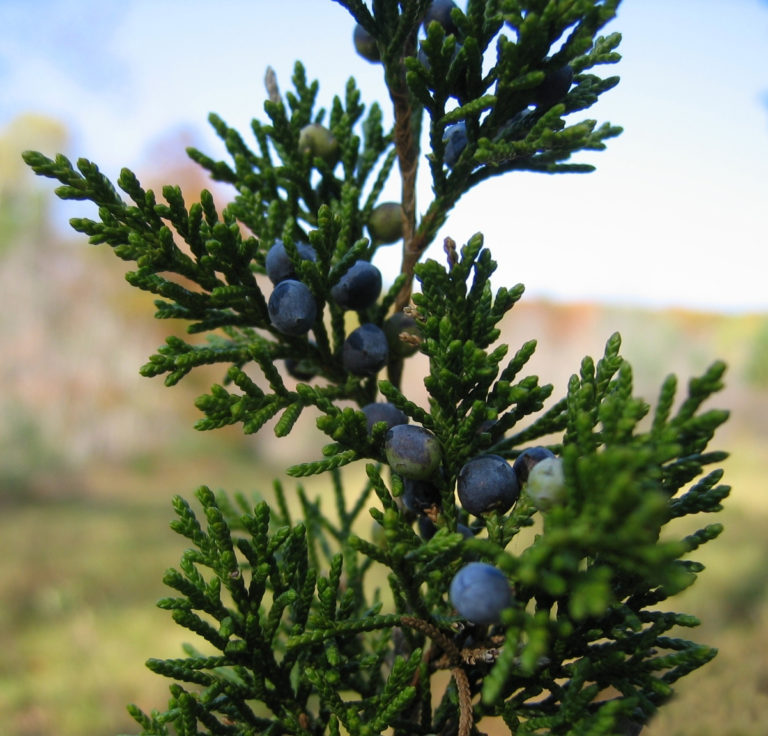Eastern Red Cedar is a sturdy, aromatic, evergreen, pyramid-shaped or columnar tree which usually grows to about 60 feet, though it can reach 90 feet. This species is considered a pioneer tree that colonizes sunny areas that are relatively dry and sterile. Adapted to dry habitats, it is native throughout central and eastern North America and is reported in mountain, piedmont and coastal plane counties of NC. Red Cedar is a wonderfully useful resource. The darker brown-red heartwood (the inner wood) is fragrant, light and durable, even in contact with soil. Because of its rot resistance, the wood is used for fence posts. Because it is aromatic and avoided by moths, it is widely used as lining for clothes chests and closets. Also, the fruits and young branches contain aromatic oil that is used in medicines. Red Cedar is dioecious (male and female flowers on separate plants). The male cones are brown and papery, the female cones resemble waxy blue berries. The female berries are used to flavor gin. Red Cedar can spread and colonize in fields if left untended long-term, and in some parts of the country is problematic now that fire is no longer allowed to control it. Birds, like the cedar waxwing, eat the waxy blue berry-like cones (a process that greatly increases seed germination rate). It is an important food source for many other birds, as well as mammals, and it provides very high quality shelter within its thick foliage for many animals, especially in winter. Eastern Red Cedar (which is actually a Juniper, not a Cedar) is a relatively long lived tree, up to 300 years in favorable conditions. Because there is so much variability in the form of individual trees, many cultivars have been developed from outstanding individuals, propagated asexually.
NURSERY HOURS
Wednesday: 10-4 Thursday: 10-6 Friday-Saturday: 10-4 Sunday: 12-4
Juniperus virginiana

Key Info
Common Names: Eastern Red Cedar, Pencil Cedar, Carolina Cedar, Virginia Red Cedar, Baton rouge, Juniper, Virginia Juniper, Red Juniper, Savin, Red Savin, Cedar Apple,Cedar tree
Family Names: Cupressaceae (Cypress Family)
Plant Type: Tree / Shrub
Leaf Retention: Evergreen
Flower Color: Blue berries
Additional Info
Habit: Upright; densely pyramidal, sometimes columnar conifer with fine to medium texture and horizontal branching. Its mature form is quite variable. The silvery to reddish-brown bark shreds and exfoliates as the tree matures. The trunk is often buttressed or fluted at the base. Root system is woody, shallow, and spreading.
Height: up to 90' but usually 60' or less 30-40'
Spread: up to 25'
Soil Conditions: Mesic to dry (not wet); circumneutral pH; nutrient-poor, sandy, rockyk sandy loam, clay loam, clay, limestone-based.
Leaves: Leaves are of two types; opposite, sharp, needlelike juvenile leaves (on young plants) or opposite, simple, green or blue-green, scale-like, overlapping, closely appressed adult leaves. The juvenile leaves are found on young plants up to 3 years old, and as scattered shoots on adult trees. Fragrant, scale-like foliage is gray-green to blue-green to light- or dark-green. All colors tend to brown in winter.
Flowers (or reproductive structures: Eastern Red Cedar is dioecious, with pollen cones (male flowers) and seed cones (female flowers) on separate trees. Male cones are yellowish-brown, 1/8 inch long, oval, papery, and produced in large groups at the tips of branchlets. They release their pollen to the wind during the spring. The seed cones are solitary at the tips of branchlets, are initially green, becoming blue, waxy-fleshy and berrylike, sweet-tasting, and resinous, ripening in September - October.
Fruit: Each seed cone typically contains 1-2 yellow-brown, ridged seeds about 1/8" long.
Natural Distribution: Dry woods, abandoned fields, fence rows, rocky bluffs, sandstone and limestone glades, roadside embankments, gravelly areas along railroads.
USDA Hardiness Zone: 2 to 9
USDA Wetland Indicator Status in NC: FACU
Pollination: Wind
Wildlife Connections: Red Cedar is a larval host for the Olive butterfly and the Juniper Hairstreak butterfly as well as larvae of many moths, flies, beetles, scales, midges and thrips. Red Cedar's blue berry-like cones, high in carbohydrates and fats, provide excellent food for a long list of song birds and upland game birds. (The Cedar Waxwing is actually named after the tree). Because of its dense foliage, a number of bird species nest in Red Cedar (Cooper's Hawk, Blue Jay, Mockingbirds, Robins, Warblers, Finches, Sparrows) and also roost there (notably owls and sparrows). Mammals which also enjoy the sweet berries include Black Bear, Gray Fox, Opossum, Eastern Chipmunk, and White-Footed Mouse. Illinoiswildflowers.info is a great resource for these connections.
Propagation: From seed.
